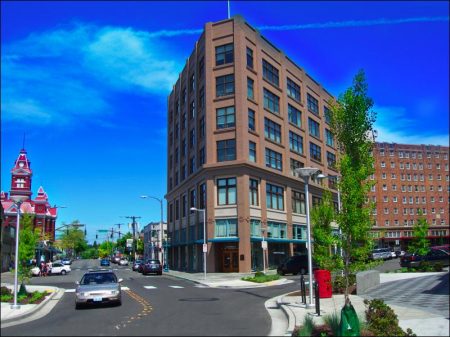Bellingham, port of call 18 miles south of the Canadian Border, industrial and educational center, and distribution point for northwestern Washington, borders the broad curve of Bellingham Bay, sweeps back over the level valleys of Whatcom, Squalicum, and Padden creeks, and climbs the slopes of Sehome Hill, which rises practically in the middle of the city.
Industrial life is concentrated along the water front, where squarely massed warehouses, coal bunkers, and piers are punctuated with the black smokestacks of mills and factories, harsh against the green hills. Moored at the docks are large, ocean-going freighters, sturdy cannery tenders, numerous small fishing boats, and trim pleasure craft. From the bayside, streets radiate into the business and residential areas, which mingle in a casual manner as a result of the merging of four separate boom towns in the formation of Bellingham.
To the west are the San Juan Islands and the interlaced ribbons of sounds and straits; more distant are the white-tipped Olympics, remote and austere, and the dark bulk of Vancouver Island, visible only on clear days. Stretching eastward from the city for 40 miles are broad fertile valleys, once unbroken evergreen forest but now largely logged off and converted into dairy farms, truck gardens, pastures, berry fields, and poultry ranches. Higher areas between the lowlands are covered with second-growth timber, interspersed with charred or bleaching stumps and fallen logs. Gradually the foothills become more rugged as they ascend toward the serrated line of the Cascades, from which rise the snow-capped peaks of Mount Baker and the Three Sisters.
From this extensive area of land and water, Bellingham has drawn sustenance: salmon for canneries, cedar and fir and hemlock logs to supply the lumber mills, and coal to feed furnaces and fill the holds of freighters. The pace of exploitation of these natural resources has been rapid; a brief half-century has seen them in a large measure depleted, so that today the prosperity of the city is becoming increasingly dependent upon the agrarian pursuits of the back country and upon the canning and processing of farm produce.
The mild climate of the region is favorable to the development of agriculture. Autumn months are temperate, with alternate rain and fog and bright, sunshiny days. In winter, freezing weather is not unknown; but, according to the records of the United States Weather Bureau, not once in 125 years has the temperature fallen to zero. Occasionally a cold, raw gale howls down from the mountains, and the city awakens in the morning heavily blanketed with snow. Now and then a sudden shift of the wind to the north converts the melting snow to a silver sheath of ice. Blustery winds sometimes sweep moisture-laden clouds up the Strait and dash them against the mainland. Then streams swirl in fury at their banks, lowlands are flooded, and the unsupported earth of steep hillsides, undermined by water, begins to slide on the clay hardpan.
Spring comes early. By March, meadows and pasture lands have lost the sallow tinge of winter, and soon the grass becomes lush and green. Throughout the mild summer, when temperatures seldom reach 90° Fahrenheit, and late into the fall, dairymen find ample pasturage for their herds, no inconsiderable factor in the growth of the dairying industry.
Visits: 99



